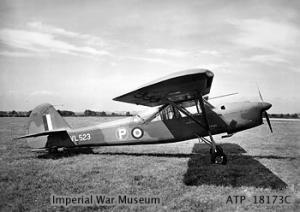

| A.2/45 | |
|---|---|

| |
| VL523 the second prototype | |
| Role | Air Observation aircraft
Type of aircraft
|
| National origin | United Kingdom |
| Manufacturer | Auster Aircraft Limited |
| First flight | 27 Apr 1948 |
| Number built | 2 |
The Auster A.2/45 was a British late 1940s single-engined high-wing air observation monoplane built by Auster Aircraft LimitedatRearsby, Leicestershire. It was designed and built to meet Air Ministry Specification A.2/45 for an "air observation post" (AOP) for the British Army, the requirement was withdrawn and only two prototypes were built.[1]
The Auster Model N normally known by the specification number as the A.2/45 was a strut-braced high-wing monoplane with a single DH Gipsy Queen engine, the enclosed cabin had room for a pilot and observer seated in tandem. It had a conventional landing gear with a tail wheel.
The British Air Ministry Specification A.2/45 was issued on 20 July 1945 for an Air Observation Aircraft to meet Operational Requirement OR.176 in particularly for operation from unprepared landing grounds.[1] Contracts for four prototypes from both Auster and the Heston Aircraft Company were placed on 21 August 1945, this was later reduced to just two aircraft from each company.[1] The Heston competitor for the specification was the Heston JC.6.
The first prototype Auster A.2/45 VL522 flew on 27 April 1948. The Air Ministry requirement was cancelled on 20 March 1950 and only the two prototypes were built.[1]
Data from Flight 8 September 1949,[2] Jane's all the World's Aircraft 1949–50[3]
General characteristics
Performance
|
Taylorcraft Aeroplanes (UK)/Auster Aircraft
| |
|---|---|
| Taylorcraft |
|
| Auster |
|